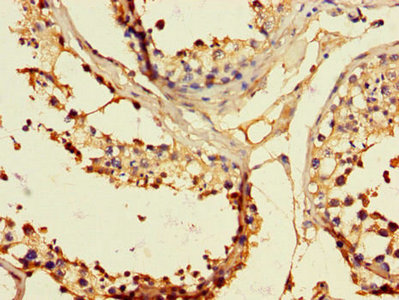
Western blot analysis of extracts from Jurkat cells, using EPHB2 antibody.
EPHB2 Antibody
CSB-PA616225
ApplicationsWestern Blot, ELISA
Product group Antibodies
ReactivityHuman
TargetEPHB2
Overview
- SupplierCusabio
- Product NameEPHB2 Antibody
- Delivery Days Customer20
- ApplicationsWestern Blot, ELISA
- CertificationResearch Use Only
- ClonalityPolyclonal
- ConjugateUnconjugated
- Gene ID2048
- Target nameEPHB2
- Target descriptionEPH receptor B2
- Target synonymsBDPLT22, CAPB, DRT, EK5, EPHT3, ERK, Hek5, PCBC, Tyro5, ephrin type-B receptor 2, EPH-like kinase 5, developmentally-regulated Eph-related tyrosine kinase, elk-related tyrosine kinase, eph tyrosine kinase 3, protein-tyrosine kinase HEK5, renal carcinoma antigen NY-REN-47, tyrosine-protein kinase TYRO5, tyrosine-protein kinase receptor EPH-3
- HostRabbit
- IsotypeIgG
- Protein IDP29323
- Protein NameEphrin type-B receptor 2
- Scientific DescriptionReceptor tyrosine kinase which binds promiscuously transmembrane ephrin-B family ligands residing on adjacent cells, leading to contact-dependent bidirectional signaling into neighboring cells. The signaling pathway downstream of the receptor is referred to as forward signaling while the signaling pathway downstream of the ephrin ligand is referred to as reverse signaling. Functions in axon guidance during development. Involved in the guidance of commissural axons, that form a major interhemispheric connection between the 2 temporal lobes of the cerebral cortex. Also involved in guidance of contralateral inner ear efferent growth cones at the midline and of retinal ganglion cell axons to the optic disk. Beside axon guidance, also regulates dendritic spines development and maturation and stimulates the formation of excitatory synapses. Upon activation by EFNB1, abolishes the ARHGEF15-mediated negative regulation on excitatory synapse formation. Controls other aspects of development including angiogenesis, palate development and in inner ear development through regulation of endolymph production. Forward and reverse signaling through the EFNB2/EPHB2 complex regulate movement and adhesion of cells that tubularize the urethra and septate the cloaca. May function as a tumor suppressor. Kiyokawa E., Cancer Res. 54:3645-3650(1994). Ikegaki N., Hum. Mol. Genet. 4:2033-2045(1995). Tang X.X., Oncogene 17:521-526(1998).
- ReactivityHuman
- Storage Instruction-20°C or -80°C
- UNSPSC41116161







